
So, you want to start a fashion blog but feel like it’s too complicated? Maybe you’re worried about the tech side of things or unsure where to begin. I get it—I used to think the same way.
But here’s the truth: Starting a fashion blog (or any blog!) is way easier than most people think. You don’t need coding skills, design experience, or fancy tech knowledge. In fact, if you can use Instagram or Pinterest, you can absolutely run a blog—90% of it is just writing posts and tweaking your layout. And the best part? It’s incredibly affordable to launch if you’re serious about it. (Psst! If you need a full step-by-step guide, check out my post on How to Start a Blog for the exact roadmap.)
Think of it like learning a new social media platform. At first, you fumbled around, but soon enough, you got the hang of it. Blogging works the same way—take it step by step, and before you know it, you’ll have a polished fashion blog that grows into a real money-making brand. Want proof? See how these Successful Fashion Bloggers built their empires from scratch. And if you’re still unsure about your niche, explore these Profitable Blogging Niches to find your perfect fit.
What You’ll Get Out of This Guide
By the time you finish this guide, you will:
✅ Have Your Own Fashion Blog – Fully set up and ready to publish your first post.
✅ Know What to Write About – No second-guessing; you’ll have a list of fashion topics to cover.
✅ Understand How to Make Money – Learn the exact steps to monetize your blog from day one.
✅ Get Your First Readers – Know exactly how to promote your blog to increase your readers over time.
Starting a blog isn’t just about writing, it’s about making money, transforming your knowledge into an online business model that makes you real money.
You can make it happen! 🚀 Let’s get started!
What You Need To Get Started
Here are the things you need to set up a standard fashion blog and get it ready for publishing your first blog post;
What You Need to Set Up Your Fashion Blog
- A Desktop or Laptop: You’ll need a computer to manage your blog, write posts, and make changes easily.
- A Domain Name: This is the name of your blog (e.g., “yourfashionblog.com”). Choose something catchy and related to fashion, or something personal to you.
- A Content Management Platform (Blogging Platform): This is where you’ll manage your blog, write posts, customize pages, and more. WordPress.org is the most popular option, and it’s easy to use without needing any coding skills. It lets you pick from pre-built themes (sites), so you can have a starting point and quickly design your blog the way you want it using a pre-built site.
- Web Hosting: Web hosting is where your website lives online. It keeps your blog accessible to everyone. You’ll need to sign up for a web hosting service like HostGator, which also gives you the option to install WordPress.org easily.
Note: Once you sign up for your web hosting, using HostGator, you’ll be able to install WordPress and start publishing blog posts and customizing your site right away.
How To Start A Fashion Blog That Makes Money In 9 Easy Steps
In this illustration, I am going to use HostGator because there are one of the best web hosting services available, good for both beginners and webmasters.
- Step 1: Start within a fashion-related sub-niche
- Step 2: Click on HostGator
- Step 3: Choose your preferred hosting plan
- Step 4: Choose your domain name
- Step 6: Adjust to your preferred hosting subscription period
- Step 6: Create your HostGator account
- Step 7: Within Your HostGator Account, Install WordPress
- Step 8: Choose A Theme for your blog theme [A Pre-built Site]
- Step 9: Customize your main pages and start publishing blog posts.
Step 1: Start Within A Fashion Sub-niche
If you’re starting a fashion blog, the first step is to narrow down your content focus. Instead of trying to cover everything at once, it’s smarter to start within a specific sub-niche, one main area within the fashion blogging space that you can start publishing content around to build your blog’s topical authority in it. This helps you stand out, attract a loyal audience, and create content that truly connects with readers.
As your blog grows, you can always expand into other fashion topics to keep things fresh and exciting.
So, what kind of fashion blog do you want to start?
Here are some popular fashion sub-niches to consider:
1. Street Style – Everyday Fashion Inspired by Urban Culture
Street style fashion is all about the casual yet trendy outfits worn by everyday people, often influenced by music, social media, and celebrity culture. This sub-niche focuses on how real people dress in real life, highlighting individuality and bold statement pieces.
🔹 Topic Ideas:
- “10 Must-Have Pieces for the Ultimate Street Style Look”
- “How to Recreate Celebrity Street Style on a Budget”
- “The Evolution of Streetwear: From Skate Parks to High Fashion”
2. Sustainable & Ethical Fashion – Fashion That’s Good for the Planet
This sub-niche focuses on eco-friendly, ethically made, and sustainable fashion choices. It promotes brands that prioritize fair labor practices, recycled materials, and minimal waste production. If you’re passionate about sustainability, this niche allows you to educate and inspire others to make conscious fashion choices.
🔹 Topic Ideas:
- “Top 10 Sustainable Fashion Brands You Should Know”
- “How to Build an Eco-Friendly Wardrobe on a Budget”
- “Fast Fashion vs. Slow Fashion: Why It Matters”
3. High Fashion & Luxury – Designer Brands & Runway Trends
If you love designer fashion and the latest runway trends, this sub-niche is perfect. It covers high-end brands, fashion week highlights, and luxury styling tips. High-fashion bloggers often review luxury products, discuss fashion history, and showcase premium outfit inspiration.
🔹 Topic Ideas:
- “The Top Fashion Week Trends to Watch This Season”
- “A Beginner’s Guide to Investing in Luxury Fashion”
- “How to Style Iconic Designer Pieces”
4. Personal Style & Outfit Inspiration – Showcasing Unique Looks
This sub-niche is all about documenting personal style and inspiring others with outfit ideas. If you enjoy curating looks, experimenting with trends, or helping others dress better, this niche allows for a more personal and creative approach.
🔹 Topic Ideas:
- “How to Define Your Personal Style in 5 Simple Steps”
- “The Ultimate Capsule Wardrobe for Every Season”
- “Mixing & Matching: How to Create New Outfits with Old Clothes”
5. Fashion for Specific Audiences – Targeting a Niche Group
Some fashion bloggers focus on specific audiences such as plus-size fashion, petite fashion, men’s fashion, or modest fashion. This makes the blog more relatable and helpful for people with unique style needs.
🔹 Topic Ideas:
- Plus-Size Fashion: “The Best Plus-Size Brands for Trendy & Comfortable Clothing”
- Petite Fashion: “How to Style Outfits to Look Taller & Proportionate”
- Men’s Fashion: “Essential Wardrobe Staples Every Man Should Own”
- Modest Fashion: “How to Stay Stylish While Dressing Modestly”
6. Fashion on a Budget – Affordable & Smart Shopping
This sub-niche is for those who love fashion but don’t want to spend a fortune. It focuses on affordable fashion finds, thrift shopping, and styling tips for looking expensive on a budget.
🔹 Topic Ideas:
- “10 Ways to Look Chic Without Spending a Lot”
- “How to Find the Best Fashion Deals Online”
- “Building a Stylish Wardrobe with Thrift Store Finds”
7. Fashion History & Trends – The Story Behind Styles
This sub-niche focuses on the evolution of fashion trends and the history of iconic styles. If you love researching past trends and how they influence today’s fashion, this could be a great niche for you.
🔹 Topic Ideas:
- “The History of the Little Black Dress: From Coco Chanel to Today”
- “Fashion Trends That Keep Coming Back: Why the ’90s Are Still In”
- “The Influence of Vintage Fashion on Modern Styles”
8. DIY Fashion & Clothing Hacks – Customizing & Upcycling Clothes
This sub-niche focuses on creative ways to personalize fashion, such as sewing tutorials, upcycling old clothes, or creating custom accessories. If you love hands-on projects, this is a great way to attract a crafty audience.
🔹 Topic Ideas:
- “Step-by-Step Guide to Creating Your Own Fashion Accessories”
- “5 Easy DIY Fashion Hacks to Transform Your Old Clothes”
- “How to Customize Your Denim Jackets with Embroidery”
The Best Sub-Niche for Your Fashion Blog
✔ Excites You – Fashion blogging takes consistency, so pick a niche you are interested in, whether it’s street style, sustainable fashion, or luxury wear.
✔ Has an Audience – Research trending topics and ensure there’s demand. Platforms like Pinterest, Instagram, and Google Trends can help you find what people are interested in.
✔ Has Monetization Potential – Some niches (like designer fashion, thrift styling, or fashion hauls) attract sponsorships, affiliate deals, and ad revenue.
💡 Pro Tip: Start with a specific niche to stand out and grow faster. Once established, you can explore broader fashion topics! 🚀
Find More Ideas – Blog Post Topic Ideas in Different Sub-niches
Step 2: Use “HostGator” To Get Started
Once you’ve picked your fashion niche, grab our HostGator discount link to get your hosting at a special price. This also lets you choose a free domain name of your choice you normally would have paid for.
HostGator is a solid, reliable, and beginner-friendly host, but there are other great options like WP hosting, Bluehost, Siteground, etc. Here are other recommended web hosting providers for new bloggers.
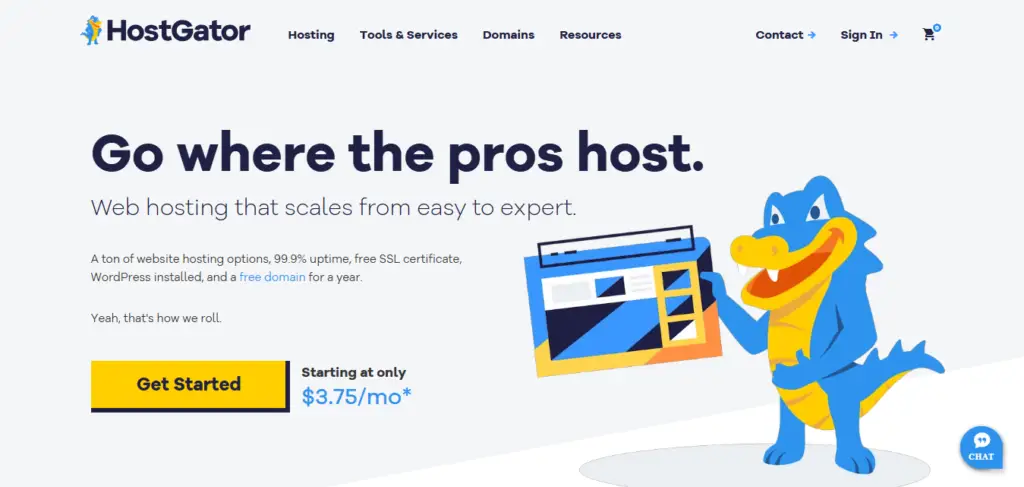
Step 3: “Pick Your Preferred HostGator Plan”
For beginners, the Hatchling Plan is your best bet. It’s affordable, and you can always upgrade later as your blog grows.
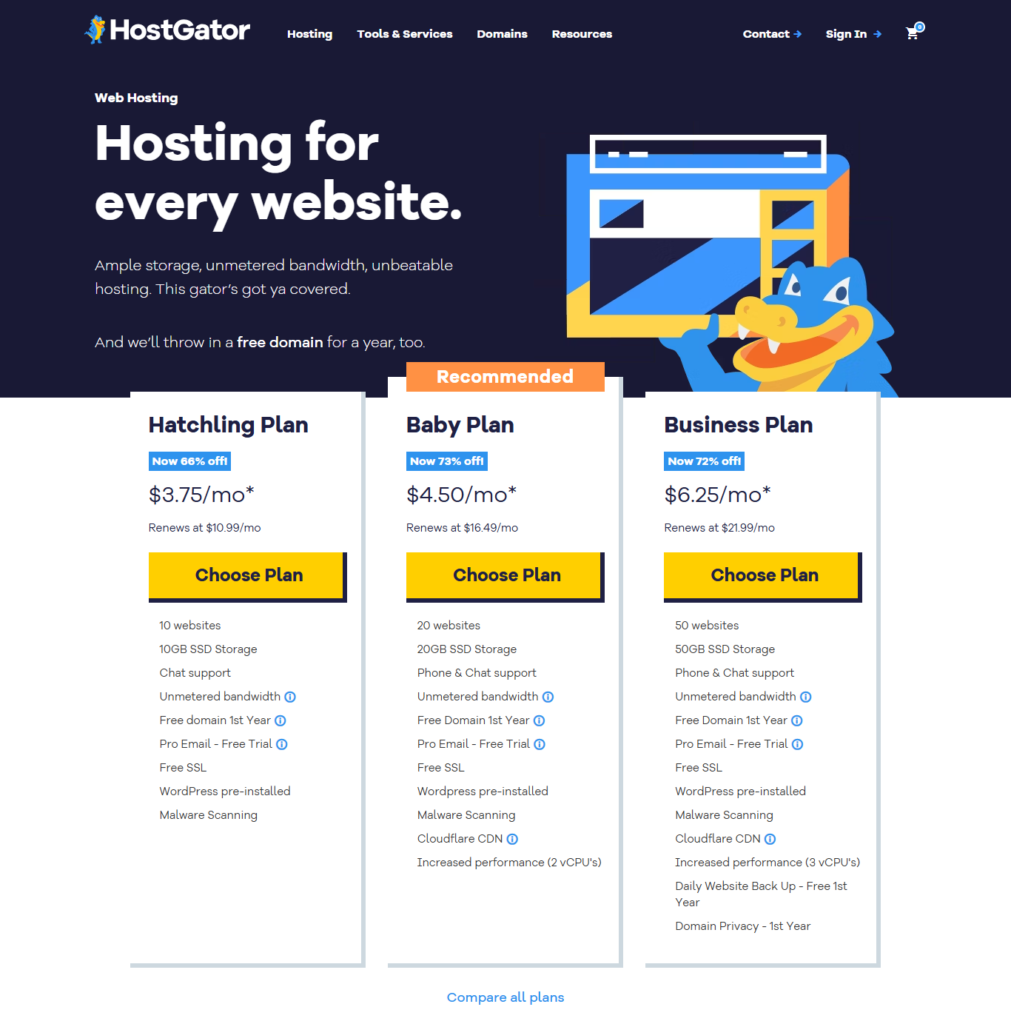
Step 4: Pick the Domain Name of Your Choice
After choosing your plan above, you will be directed to a page like the one below to choose your domain name and complete your sign-up.
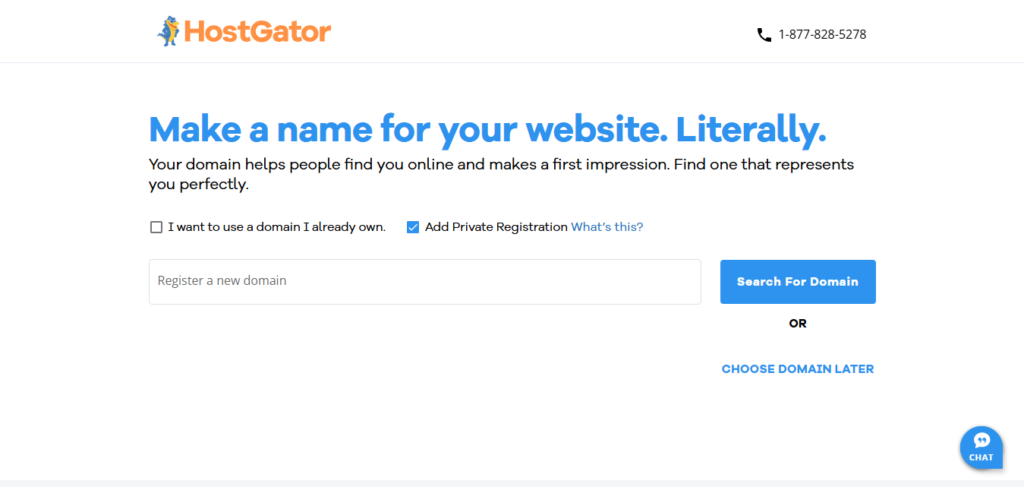
What to Consider When Choosing Your Fashion Blog Domain Name
- Make It Stylish & Easy to Remember – Your domain name should be catchy and effortless to type. Avoid long, complicated words, numbers, or hyphens.
- Reflect Your Fashion Niche – Whether you’re blogging about street style, high fashion, or sustainable clothing, your domain name should hint at your content. Consider including words like “style,” “chic,” “couture,” or “vogue.”
- Keep It Short & Simple – A domain name between 6-14 characters is ideal. Shorter names are easier to remember and less prone to typos.
- Avoid Confusing Spellings – If your domain name is hard to pronounce or includes double letters, readers may struggle to type it correctly. Clarity is key.
You can find “300+ Fashion-related Blog Name Ideas“
Step 5: Set Your Hosting Subscription Period
Ensure you’re on the Hatchling plan on the left and set your subscription to either 1 year or 36 months, depending on what fits your budget.
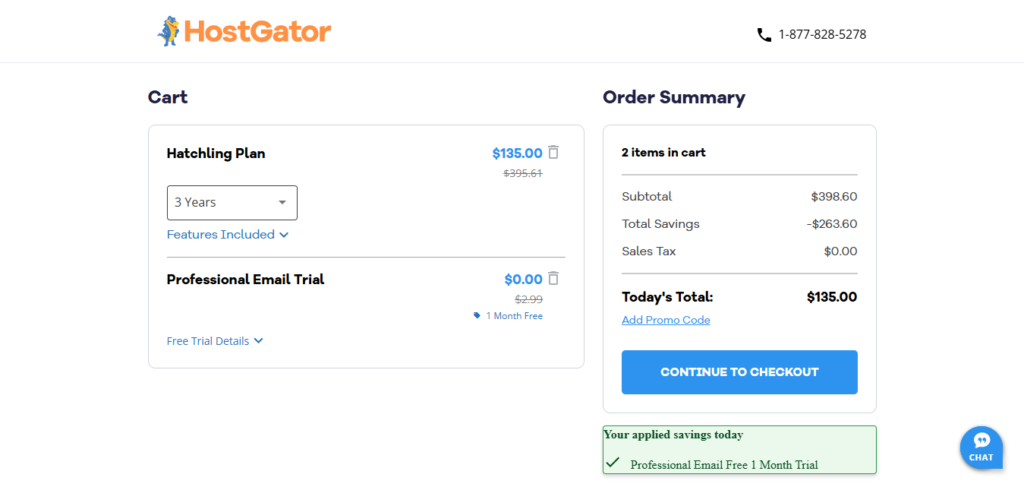
Step 6: Complete Your Account Creation
Before checkout, create your Hosting account with HostGator by entering your personal details and choosing your account password.
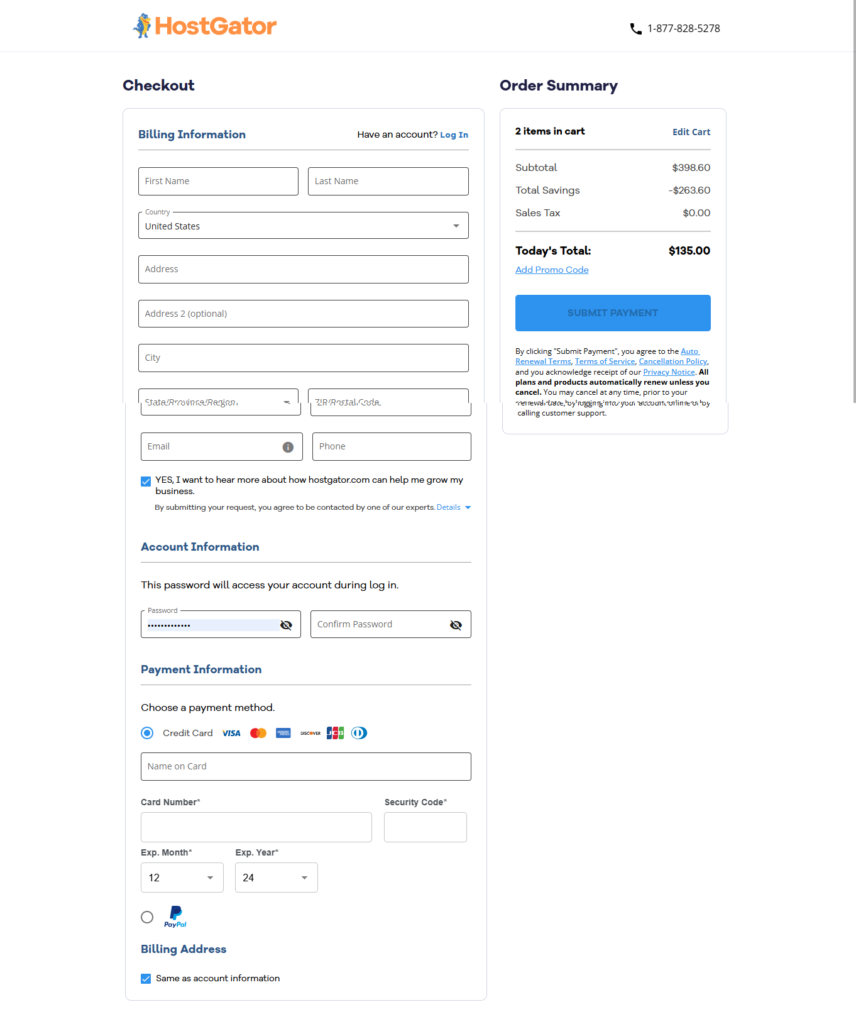
Step 7: Access WordPress Within Your HostGator Account
- Follow the on-screen steps after your HostGator sign-up to complete your WordPress installation.
- Alternatively, log in to HostGator, go to “Websites” or “WordPress”, and click to create your WordPress account.
- Once set up, you’ll be logged in and ready to start building posts and customizing your blog pages.
Step 8: Pick a Theme for Your Fashion Blog
Your theme is the foundation of your blog’s design; it sets the tone for your style and makes your content pop. Luckily, WordPress has tons of free and paid themes to choose from, and picking one is simple. [ WordPress themes are prebuilt website templates you can edit and use.]
Here’s how to do it:
1. Go to the Themes Section
- In your WordPress dashboard, find “Appearance” on the left sidebar.
- Click on “Themes” to access the theme library.
2. Browse and Search for a Theme
- Use the search bar to find themes designed for fashion blogs. Try keywords like “fashion,” “grid layout,” or “modern.”
- You’ll see both free and premium themes—free is great for beginners, while paid themes offer more customization.
3. Narrow Down Your Options
- Look for Key Features: Fashion blogs thrive on visuals, so find a theme with:
- Gallery and slideshow options
- Social media integration
- Customization settings (fonts, colors, layout)
- Choose a Good Layout: A clean, grid-style layout helps showcase outfits and photos beautifully.
- Check Responsiveness: Make sure the theme looks great on phones and tablets since most visitors will browse on mobile.
4. Preview Before You Pick
- Hover over a theme and click “Preview” to see how it looks in action.
- If it aligns with your vision, go ahead and activate it!
5. Read Reviews & Ratings: Check what other users say about the theme’s ease of use, speed, and support.
6. Consider a Premium Theme (Optional)
- If you want more control over your blog’s design, a paid theme might be worth it. But if you’re new, a free theme works just fine!
Once you’ve picked your theme, you’re ready to start designing and customizing your fashion blog! 🎉
Here are some of the best WordPress themes for fashion blogs you can consider using.
Step 9: Style Your Fashion Blog & Start Posting Like a Pro
It’s time to make your fashion blog as stylish as your wardrobe!
Here’s how to customize and launch with flair:
1. Create Your Runway-Worthy Design
- Choose colors that reflect your aesthetic (pastels for boho, neons for streetwear)
- Select chic fonts (playful scripts for girly blogs, clean sans-serifs for minimalist vibes)
- Add a stunning full-width header of your best outfit shot
2. Must-Have Pages for Fashion Influencers:
👗 About Page: “My Style Journey” (with your best fashion portrait)
📸 Lookbook: Grid layout of your favorite outfits
🛍 Shop My Closet: Perfect for affiliate links
✉️ Collab Page: “Work With Me” for brand partnerships
3. Publish Your First Fabulous Post
Start with these trending formats:
- “How I Styled This [Trend] 5 Different Ways”
- “Spring Capsule Wardrobe Under $200”
- “The Truth About [Viral Fashion Item] – Honest Review”
👠 Pro Fashion Blogger Tools:
- ShopStyle Collective (for monetizing outfit posts)
- Envira Gallery (for stunning lookbooks)
- Dressing Room (virtual try-on widgets)
You’re Ready for the Spotlight! Your blog can now:
- Get featured in fashion roundups
- Land brand sponsorships
- Earn through affiliate programs (like RewardStyle)
First Week Style Strategy:
- Post 3 diverse looks (1 trend piece, 1 budget find, 1 luxury splurge)
- Create an Instagram account and cross-post
- Join Facebook groups like “Fashion Blogger Support.”
Find Fashion-Related Blog Posts To Write About
Now that your blog is set up, it’s time to fill it with fresh, engaging content that attracts readers and keeps them coming back.
Here’s how to discover trending blog topics, spark creativity, and plan posts that resonate with your audience.
1. Get Inspired by Trends
Stay ahead of the curve by exploring:
✅ Google Trends – See what’s surging in searches (e.g., “cottagecore outfits 2024”).
✅ Pinterest Predicts – Discover upcoming fashion trends before they peak.
✅ Instagram & TikTok Hashtags – Check #OOTD, #FashionTrends, or niche tags like #DarkAcademiaFashion.
Pro Tip: Set up Google Alerts for keywords like “sustainable fashion” or “streetwear trends” to get fresh ideas delivered to your inbox.
2. Evergreen Fashion Blog Post Ideas
These timeless topics always attract readers:
- Outfit Guides – “10 Minimalist Outfits for a Capsule Wardrobe”
- Seasonal Trends – “Spring 2025 Fashion Trends Worth Trying”
- Budget Styling – “How to Look Expensive on a Thrift Store Budget”
- Celebrity Style Breakdowns – “How to Dress Like [Celebrity] for Less”
- Shopper’s Guides – “Best Vegan Leather Bags Under $100”
Tip: Add affiliate links (like ShopStyle or Amazon) to monetize shopping guides!
3. Answer Real Fashion Questions
Check these places for what people are actually searching:
🔍 Reddit – r/femalefashionadvice, r/malefashion
🔍 Quora – “How do I style wide-leg jeans for petite frames?”
🔍 Facebook Groups – “Sustainable Fashion Enthusiasts”
Example Post: Turn a common question like “Are mom jeans still in style?” into a debunking trends article.
4. Repurpose & Refresh Old Content
Give past trends a new spin:
- “2025 Update: Are Skinny Jeans Really Dead?”
- “Revisiting Y2K Fashion – What’s Worth Wearing Now?”
SEO Hack: Update old posts with new images and keywords to boost Google rankings.
5. You Can Use AI Tools for Quick Ideas
Try these free AI writing tools to brainstorm:
- ChatGPT – “Give me 10 fashion blog post ideas for a vintage style blog.”
- AnswerThePublic – Shows real searches like “how to wear a blazer casually.”
Example Output:
“How to Style a Scarf 5 Different Ways”
6. Create a Content Calendar
Plan ahead with a mix of post types:
📅 Weekly: Trend reports, quick styling tips
📅 Monthly: Deep dives (e.g., “The History of Punk Fashion”)
📅 Seasonal: Gift guides, holiday outfit ideas
Round-Up: Best Tools to Generate Fashion Blog Post Ideas
Stuck in a creativity rut? These tools will help you unlock endless fashion blog topics while optimizing them for traffic and revenue.
- AI Writing Tools (For instant inspiration)
- ChatGPT or Jasper: Ask, “Give me 10 trending fashion blog post ideas for [season/audience].”
- Copy.ai: Uses AI to brainstorm catchy titles (e.g., “Spring Capsule Wardrobes on a Budget”).
- Keyword Research Tools (Find what your audience searches for)
- Google Keyword Planner (Free): Discover terms like “sustainable fashion brands 2025.”
- AnswerThePublic: Visualizes questions (e.g., “How to style wide-leg jeans for petite women?”).
- SEO & Blog Generators (Data-driven ideas)
- SEMrush or Ahrefs: Spy on competitors’ top-performing fashion posts.
- HubSpot’s Blog Ideas Generator: Plug in nouns like “vintage outfits” for instant prompts.
- Content Writing Tools (Polish your ideas)
- Grammarly: Ensures your drafts are error-free.
- Notion or Trello: Organize ideas into editorial calendars.
- Blogging Tools (Streamline your workflow)
- Canva: Create pins for Pinterest-worthy post ideas.
- BuzzSumo: See viral fashion content to adapt.
Pro Tip: Combine these tools! Use keyword research tools to find keywords ideas, then AI to refine angles. Example:
“AnswerThePublic + ChatGPT = ‘How to Style Athleisure for Work (Without Looking Sloppy)’”
Final Tip: Make It YOUR Voice
Whether you’re into streetwear, sustainable fashion, or luxury dupes, your unique perspective is what will make your blog stand out.
Now, go write that first post! Need help structuring it? How To Format A Blog Post
Find more Ideas – Blog Post Topic Ideas in Different Sub-niches
How to Monetize Your Fashion Blog & Start Earning
So, you’ve published a few posts on your fashion blog, now what? It’s time to turn your passion into profit! Monetizing a fashion blog is easier than you think, especially with the right strategies.
Below, we’ll break down the best ways to make money from your blog, step by step.
1. Monetize with Display Ads (Easy Passive Income)
Display ads are one of the simplest ways to start earning from your blog. Google AdSense is the best starting point for beginners because it’s easy to set up and runs automatically.
How to Set Up Google AdSense on Your Fashion Blog
✅ Step 1: Sign Up for Google AdSense
- Visit Google AdSense and click “Sign Up.”
- Submit your blog’s URL and basic info.
- Google will review your site (this can take a few days).
💡 Pro Tip: To increase approval chances, have at least 5-20 blog posts published before applying. (How many blog posts do you need to make money?)
✅ Step 2: Add AdSense Code to Your Blog
- Once approved, Google will give you a unique ad code.
- Place this code in your blog’s header, sidebar, or within posts.
- If you use WordPress, plugins like Ad Inserter make setup effortless.
✅ Step 3: Start Earning from Ads
- Google serves automated, relevant ads based on your content and audience.
- You earn when visitors click ads (CPC) or view them (CPM).
💰 How Much Can You Make?
- Beginners typically earn $500 – $2,000/month with AdSense.
- As traffic grows, earnings increase significantly. (See fashion blog income reports)
🔹 Want higher payouts? Once you hit 10k+ monthly pageviews, apply for premium ad networks like Mediavine or AdThrive (Best ad networks for bloggers).
2. Make Money with Affiliate Marketing (High Earnings Potential)
Affiliate marketing is one of the most profitable ways to monetize a fashion blog. You recommend products, and when readers buy through your links, you earn a commission.
How to Start with Affiliate Marketing
✅ Step 1: Join Affiliate Programs
- Amazon Associates – Great for fashion, accessories, and beauty products.
- RewardStyle (LIKEtoKNOW.it) – Perfect for Instagram + blog monetization.
- ShareASale & CJ Affiliate – Features brands like Nordstrom, Revolve, and more.
- Rakuten Advertising – Works with luxury and high-end fashion brands.
Find More: 16 High-paying Affiliate Programs
✅ Step 2: Strategically Place Affiliate Links
- Product roundups – “10 Best Denim Jackets for Fall”
- Outfit posts – Link items you’re wearing.
- Gift guides – “Best Luxury Handbags Under $500”
- Comparison posts – “Zara vs. H&M: Which Jeans Are Worth It?”
💰 How Much Can You Earn?
- Commissions range from 4% (Amazon) to 20%+ (boutique brands).
- Successful fashion bloggers make $5k – $15k/month from affiliates. (Blog income reports to inspire you)
💡 Pro Tip: Increase conversions by writing honest reviews and using lifestyle images with shoppable links.
Relevant Post: Affiliate Blog Topic Ideas
3. Boost Your Earnings with These Extra Strategies
If you want to scale your income faster, you have to apply the right blogging strategies and use additional methods of blog monetization like ones mentioned below:
🔹 Sponsored Posts – Partner with brands for paid collaborations.
🔹 Sell Digital Products – Create an eBook, a styling guide, or printables.
🔹 Offer Services – Freelance writing, virtual styling, or social media consulting.
🔹 Membership/Subscriptions – Offer exclusive content for a fee.
Find More: Here are Other Ways to Monetize Your Fashion Blog and Make Money
How Long Does It Take to Make Money Blogging?
- First 3–6 months: Focus on growing traffic and testing monetization.
- 6–12 months: Start seeing consistent income ($500 – $2K/month).
- 1+ year: Scale to $5k+ per month with multiple income streams.
Relevant:
Final Thoughts: Start Monetizing Today!
The key to making money from your fashion blog is consistency + multiple income streams. Start with Google AdSense and affiliate marketing, then expand into sponsorships and digital products when your blog starts getting more traffic.
🚀 Next Steps:
- Apply for AdSense today.
- Sign up for 2–3 affiliate programs.
- Write high-converting posts with affiliate links.
- Track progress and scale up!
Want proof it works? Check out these fashion blog income reports for real success stories!
How to Promote Your Fashion Blog Posts to Increase Traffic
Now that you’ve set up your fashion blog, written great content, and monetized it, the next step is driving traffic. Without visitors, even the best blog won’t make money.
The only two sustainable ways to grow your blog traffic organically are:
- SEO (Search Engine Optimization) – Getting free traffic from Google.
- Social Media Promotion – Leveraging platforms like Pinterest, Instagram, and TikTok to attract readers.
Let’s break down how to use both effectively for your fashion blog.
1. SEO: The Best Way to Get Free, Long-Term Traffic
SEO ensures your fashion blog posts rank high on Google, bringing in consistent traffic without paid ads. Here’s how to optimize your posts:
🔍 Keyword Research
- Use tools like Google Keyword Planner, Ubersuggest, or SEMrush to find fashion-related keywords.
- Target long-tail keywords (e.g., “best summer dresses for petite women 2025”) instead of broad ones (“dresses”).
- Include keywords in:
- Post titles
- Headings (H2, H3)
- First 100 words
- Image alt text
- Make sure to format your blog with good paragraphs, bullet points, and also add images to make it more satisfying.
📝 High-Quality, Helpful Content
- Google rewards detailed, original content. Instead of short posts, create ultimate guides (e.g., “How to Style Denim Jackets: 10 Outfit Ideas”).
- Answer common fashion questions (e.g., “How to Dress for Your Body Type”).
Find More: How to Write a Quality Blog Post in Simple Steps
🔗 Internal & External Linking
- Link to your own related posts (e.g., if writing about “Winter Outfits,” link to your “Best Winter Boots” post).
- Link to authoritative sites (e.g., Vogue, Who What Wear) to boost credibility.
🚀 On-Page SEO Tips
- Optimize images (compress with TinyPNG, use descriptive filenames like “black-leather-jacket-outfit.jpg”).
- Improve page speed (use a fast theme, enable caching).
- Use meta descriptions (convince readers to click from Google).
For a deeper dive, read our guide on [how to optimize your blog posts for SEO].
2. Social Media Promotion: How to Drive Instant Traffic
SEO takes time, but your social media content promotion effort can get you traffic results immediately. Here’s how to use each platform for your fashion blog:
📌 Pinterest (Best for Blog Traffic)
- Create vertical pins (1000x1500px) with catchy text.
- Use keywords in pin titles & descriptions.
- Join group boards to reach more people.
- Post multiple pins per blog post (different designs, angles).
Find More: How to Use Pinterest for Fashion Blogging
📸 Instagram (Brand Building & Traffic)
- Post Reels & Carousels (e.g., “5 Ways to Style a Blazer”).
- Add “Link in Bio” (use Linktree if needed).
- Engage with fashion hashtags (#OOTD, #FashionBlogger).
Find More: How to Use Instagram for Blogging
🎥 TikTok & YouTube Shorts (Viral Potential)
- Create quick styling tips, hauls, or trends.
- Use trending sounds & hashtags (#FashionTips, #OutfitIdeas).
- Link to your blog in the bio or comments.
📧 Facebook & Twitter (Secondary Traffic Sources)
- Share blog posts in Facebook Groups (e.g., “Fashion Bloggers Support Group”).
- Tweet threads with styling tips linking back to your blog.
🚀 Want to Skyrocket Your Blog Traffic Fast?
Don’t just write—dominate your niche! Dive deeper with these power-packed guides:
- 📈 How to Get Traffic to Your Blog (Proven tactics to boost visitors instantly!)
- 💡 Best Blogging Strategies (The ultimate playbook for long-term growth!)
💥 Bonus Tip: Combine these strategies with the previous blogging tools I mentioned above to 2X your results!
Bonus Tips: Other Ways to Boost Traffic
While SEO & social media are the main drivers, these tactics help too:
✍️ Guest Blogging (Free Backlinks & Exposure)
- Write for other fashion blogs (e.g., “How to Build a Capsule Wardrobe” for a minimalism blog).
- Include a link back to your blog in the author bio.
- Find guest posting sites for your niche to do guest blogging. You can also find fashion guest posting sites to tailor your effort to your niche and build more effective backlinks.
📬 Build an Email List (Direct Traffic)
- Offer a freebie (e.g., “10 Must-Have Wardrobe Essentials Checklist”).
- Send weekly newsletters with blog updates.
Learn More: [How to build an email list for your blog].
📊 Track Your Traffic
- Google Analytics [Use to see all traffic details of your site]
- Google Search Console [Use to see your site’s Google search traffic.
Learn More: How To Check Your Website Traffic
Final Thoughts: Avoid These Blogging Mistakes
Many fashion blogs fail because they:
❌ Don’t use SEO (relying only on social media).
❌ Post inconsistently (Google & followers prefer regular content).
❌ Ignore Pinterest (the #1 traffic source for fashion blogs).
For more pitfalls, see [reasons why blogs fail] and [common blogging mistakes].
How Much Money Do Fashion Blogs Make
Here’s a breakdown of how much money fashion bloggers make, categorized by their levels: beginner, average, and established blogs.
With this, you can estimate how much you are likely to make, having the number of estimated posts taking the average time required to get there.
Beginner Fashion Blogs
- Average Monthly Income: $300 – $2,500
- Average Required Monthly Traffic: 10,000 – 30,000 visitors
- Minimum Time Required To Achieve: First 3 months – 6 months
- Number of Blog Posts: 30 – 80 posts
- Most Common Methods of Monetization:
- Affiliate marketing (fashion-related products like clothing and accessories)
- Display ads (Google AdSense or other ad networks)
- Sponsored posts from fashion a related brands
Average Fashion Blogs
- Average Monthly Income: $5,000 – $15,000
- Average Required Monthly Traffic: 50,000 – 100,000 visitors
- Average Required Time To Achieve: 6 months – 2 years
- Average Number of Published Blog Posts: 80 – 150 posts
- Most Common Methods of Monetization:
- Affiliate marketing (with higher-end brands or retailers)
- Sponsored posts from niche-related brands
- Ad networks with high payouts (Mediavine, AdThrive)
- Fashion brand partnerships (collaborations, ambassadorships)
- Digital products (e.g., styling courses and ebooks)
Established Fashion Blogs
- Average Estimated Monthly Income: $15,000 – $40,000+
- Average Required Monthly Traffic: 200,000+ visitors
- Average Required Time to Achieve: 2 – 4 years
- Average Number of Published Blog Posts: 150 – 300 posts
- Most Common Methods of Monetization:
- Affiliate programs (e.g., luxury brands)
- High-paying sponsored posts and collaborations with major brands
- Selling branded merchandise or fashion products
- Digital products (e.g., styling courses and ebooks)
- Ad networks with high payouts (Mediavine, AdThrive)
Note: These figures are industry average results, your actual earnings can vary based on several factors. Here are real income report from fashion blogs to inspire you.
Examples of Successful Fashion Blogs and Their Earnings—Proof You Can Do It Too!
Here are some examples of fashion blogs to inspire you. If you’re wondering if a fashion blog can be profitable, just look at these inspiring examples:
[A]. Chic Pursuit
Overview – Chic Pursuit is a fashion and lifestyle blog run by Maria Julia. It focuses on luxury fashion, beauty, and style tips. The blog offers advice on curating a chic wardrobe, finding the best beauty products, and achieving a luxurious lifestyle on a budget. Maria also shares her experiences with travel, personal finance, and entrepreneurship.
Blog’s Insights
- Monthly Income – $11,376
- Monthly Traffic – 62,000+
- Number of posts – 500+
- Methods of monetization – Display ads, Affiliates, sponsorship deals, and ebook sales
[B]. Sandy a la Mode
Overview – Sandy a la Mode is a fashion and lifestyle blog by Sandy Chang, focusing on motherhood, affordable fashion, and family life. The blog features style inspiration for women, outfit ideas, and tips for dressing kids and moms. Sandy also covers topics like home décor, travel, and parenting.
Blog’s Insights
- Monthly Income – $3,650.44
- Monthly Traffic – 8,000+
- Number of posts – 200+
- Methods of monetization – affiliate marketing, sponsored posts,
[C]. Fit Mommy in Heels
Overview – Fit Mommy in Heels is a fashion and lifestyle blog by Lauren, a mom and former teacher, who shares style tips, fitness advice, and relatable content for women, especially mothers. The blog focuses on affordable fashion finds, outfit ideas, beauty recommendations, and maintaining a healthy lifestyle.
Blog’s Insight
- Monthly Income – $5,653.34
- Monthly Traffic – 15,000+
- Number of posts – 300+
- Methods of monetization – affiliate links, sponsored posts, and ads.
[D]. Affordable by Amanda
Overview – “Affordable by Amanda” is a fashion and lifestyle blog run by Amanda Burrows, focusing on budget-friendly fashion, beauty, and lifestyle content. The blog shares affordable outfit ideas, fashion trends, beauty tips, and product reviews, often showcasing items from retailers like Target, Walmart, and Amazon.
Blog’s Insight
- Monthly Income – $4,425
- Monthly Traffic – 10,000+
- Number of published posts – 400+
- Utilized Methods of monetization – affiliate products, sponsorship deals, and display ads.
Simplified Summary
You now have everything you need to create, monetize, and scale a successful fashion blog—from finding your unique style to turning your passion into profit. Here’s a quick recap of what we’ve covered:
✅ How to Start a Fashion Blog – Simple steps from domain setup to launching on WordPress.
✅ Content Ideas – Trendy post topics to attract fashion lovers and keep them engaged.
✅ Monetization Strategies – Earn through ads, affiliate links, brand collaborations, and more.
✅ Promotion & Growth – Proven tactics to boost traffic, grow your audience, and increase earnings.
Now, let’s get your fashion blog live and thriving!
👗 Quick Start Guide: How to Set Up a Profitable Fashion Blog
- Step 1: Choose a fashion sub-niche (e.g., sustainable fashion, luxury dupes, streetwear, or petite styling).
- Step 2: Sign up with HostGator (or your preferred hosting provider).
- Step 3: Select a hosting plan (starter plans are perfect for new bloggers).
- Step 4: Pick a domain name (make it stylish, memorable, and niche-specific—like “ChicOnBudget.com”).
- Step 5: Choose your hosting subscription length (longer plans = bigger savings).
- Step 6: Create your HostGator account and complete payment.
- Step 7: Inside your account, install WordPress (easy one-click setup!).
- Step 8: Pick a fashion-focused theme (look for clean, visual-heavy designs).
- Step 9: Customize key pages (Home, About, Contact) and start publishing posts!
What’s Next?
Now that your blog is live, focus on:
✔ High-quality content (outfit posts, trend reports, styling tips).
✔ SEO & Pinterest (drive traffic with keywords and pins).
✔ Social media growth (Instagram & TikTok for engagement).
✔ Monetization (apply for affiliate programs like RewardStyle and Amazon Associates).
Your fashion empire starts now—take the first step, stay consistent, and watch your influence (and income) grow! 💃🛍️
Other Related Posts
- How to Submit Your New Site to Google [Google indexing]
- How to Write High-quality Blog Posts
- Fashion Blog Name Ideas
- How to Create Your Fashion Site Logo
- How to Promote Your New Site and Get Traffic
- 26 Mistakes New Bloggers Often Make
Other Types of Blog You Can Start
💰 High-Demand, High-Earning Niches
- How to Start a Travel Blog and Make Money (Evergreen, affiliate-rich)
- How to Start a Food Blog and Make Money (Massive audience, ad & sponsorship potential)
- How to Start a Lifestyle Blog and Make Money (Versatile, multi-income streams)
- How to Start a Tech Blog and Make Money (High-paying ads & sponsorships)
- How to Start a Fitness Blog and Make Money (Recurring revenue from programs/products)
📈 Steady-Growth, Profitable Niches
- How to Start a Mom Blog and Make Money (Family-focused brands pay well!)
- How to Start a Beauty/Skincare Blog and Make Money (PR samples + affiliate sales)
- How to Start a Home Decor/DIY Blog and Make Money (Pinterest-friendly, product reviews)
- How to Start a Wedding Blog and Make Money (Luxury affiliate partnerships)
- How to Start a Photography Blog and Make Money (Sell presets, courses, prints)



